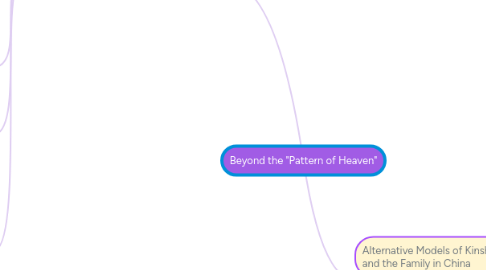
1. Alternative Models of Kinship and the Family in China
1.1. The Dai
1.1.1. Bilateral kinship; recognizes both mother and father
1.1.2. Lack surnames but use proper names. Males begin with the syllable Ai and females begin with Yi.
1.1.3. Men move to the women's natal home for 3 years. The might stay for a longer period or move to the man's natal village. (They have options)
1.1.4. Divorce can come from either male or female. Female can move back home.
1.1.5. Parents lose name to eldest child. Name becomes "Parent of ..."
1.2. The Lahu
1.2.1. Men and women work together. Family is ran as a team effort. Shared workload.
1.3. The Mosuo
1.3.1. Matrilineal family. Male/female pairing - "Walking marriage"
1.3.2. Both men and women live separately in their natal homes. Relationship is based upon sexual needs and procreation.
1.3.3. Division of labor
1.3.4. Children born from walking marriages are never disowned. Mother's brother is the male role model.
2. The Han Chinese (206 B.C. - 220 A.D.)
2.1. Confucianism
2.1.1. Founded by Kong Fuzi in 6th century B.C.
2.1.2. "An open system, and people may join through self cultivation, not by birth."
2.1.3. Emphasis that "filial piety is the pattern of Heaven", without this belief humans are subject to chaos and disorder.
2.1.3.1. Children should honor their parents equally.
2.1.3.2. Men should become gentlemen (junzi), act with compassion (ren), and observe with propriety (li). Women should be a good wife and mother and help their sons and husbands become gentlemen (junzi).
2.1.3.3. The 5 relationships: ruler/minister, father/son, elder brother/younger brother, husband/wife, friend/friend. (These are believed to keep society from engaging in conflict and maintain harmony.)
2.2. Patrilineal Kinship
2.2.1. Genealogies were created to make male hegemony permanent. Women were only noted as family members. Any termination in relationships was not noted. Women we only seen as a means to keep their lineage alive and continuous.
2.3. The Surname
2.3.1. People with the same surnames we believed to be descended from a common ancestor. If two surnames consisted of different characters but were pronounced the same those people could not marry.
2.4. Life Stages of the Han Chinese Woman
2.4.1. They believe that women should behave a certain way. Women most always rely on men. The most important day for a women is her marriage. They were removed from their kin to form new families. Divorce was something that a women couldn't initiate.
2.5. Nuanced Approaches to Han Chinese Gender and Kindship
2.5.1. Idea of a mother-centered family unit that serves women that have been cut from their kin.
2.6. Post-1949 Trends
2.6.1. People's Republic founded in 1949
2.6.2. Chinese Communist Party created new policies that strengthened the Chinese family by providing extended family networks/kin.
2.6.3. 1950 - Women obtained the right to divorce, outlawed practices of concubinage, and child marriage.
2.6.4. 1979 - one-child policy. This led to a disproportion of girl to boy ratio.
